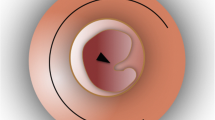Abstract
The perforation size affects the success of tympanic membrane (TM) reconstruction, in addition to the surgical technique used. Large TM perforations present a surgical challenge. The perforation size has been reported to be a prognostic factor, and poorer results are obtained with large versus small perforations. We aimed to evaluate patients who had undergone tympanoplasty for large perforations at our clinic using either the underlay or over-underlay technique and to compare the results in terms of re-perforation, retraction, lateralization, and improvement of hearing. Of 302 patients with chronic otitis media, 114 who had a perforation that involved over 50 % of the pars tensa were enrolled in the study. The underlay technique was used in 61 patients, and the over-underlay technique in 53 patients. In the underlay group, the preoperative mean perforation size was 30.11 ± 5.35 mm2 (range 20.00–52.00 mm2) (n = 61). In the over-underlay group, the preoperative mean perforation size was 31.41 ± 8.65 mm2 (range 22.00–48.00 mm2) (n = 53). The graft success rate of tympanoplasty performed using the underlay technique was 89.1 % in 61 patients. Seven (10.9 %) patients had graft failure. The graft success rate with the over-underlay technique in 53 patients was 90.5 %. Five (9.5 %) patients had graft failure in this group. Three graft lateralizations (5.6 %) and two retractions (3.8 %) were observed at 12 months postoperatively in the over-underlay group. However, in the underlay group, no graft lateralization but five retractions (8.2 %) were observed at 12 months. The graft-take rates and hearing improvement results in both groups were successful and compatible with those in the literature.



Similar content being viewed by others
References
Luetje CM (2006) Reconstruction of the tympanic membrane and ossicular chain. In: Bailey B, Johnson J, Newlands S (eds) Head & neck surgery otolaryngology, 4th edn. Williams & Wilkins, Lippincott
Zahnert T, Huttenbrink KB, Murbe D, Bornitz M (2000) Experimental investigation of the use of cartilage in tympanic membrane reconstruction. Am J Neurotol 21:322–328
Rizer FM (1997) Overlay versus underlay tympanoplasty. Part I: historical review of the literature. Laryngoscope 107:1–25
Wehrs RE (1999) Grafting techniques. Otolaryngol Clin N Am 30(3):443–455
Lee HY, Auo HJ, Kang JM (2010) Loop overlay tympanoplasty for anterior or subtotal perforations. Auris Nasus Larynx 37:162–166
Gerlinger I, Ráth G, Szanyi I et al (2006) Myringoplasty for anterior and subtotal perforations using KTP-532 laser. Eur Arch Otorhinolaryngol 263:816–819
Gersdorff M, Gerard J, Thill M (2003) Overlay versus underlay tympanoplasty: comparative study of 122 cases. Rev Laryngol Otol Rhinol 24:15–22
Raghavan U, Malik DSI, Mahmoud NA (2000) Myringoplasty: update on onlay pedicle skin flap and temporalis fascia sandwich graft. J Laryngol Otol 114:174–177
Farrior JB (1983) The anterior tympanomeatal angle in tympanoplasty: surgical techniques for the prevention of blunting. Laryngoscope 93:992–997
Shea JJ Jr (1960) Vein graft closure of eardrum perforations. J Laryngol Otol 74:358–362
Tabb HG (1968) Experience with transcanal and postauricular myringoplasty. In: Transactions of the Pacific Coast Ophthalmological Society Annual Meeting, 52:121–125
Kartush JM, Michaelides EM, Becvarovski Z, LaRouere MJ (2002) Over-under tympanoplasty. Laryngoscope 112:802–807
Lee P, Kelly G, Mills RP (2002) Myringoplasty: does size of the perforation matter? Clin Otolaryngol 27:331–334
Indorewala S (2005) Dimensional stability of free fascia grafts:clinical application. Laryngoscope 115:278–282
Green DS (1983) Pure tone air conduction testing. In: Katz J (ed) Handbook of clinical audiology, 2nd edn. Waverly Press, Baltimore, pp 98–108
Sade J (1979) The atelectatic ear. In: Sade J (ed) Secretory otitis media and its sequelae. Churchill Livingstone, London, pp 64–68
Adkins WY, White B (1984) Type I tympanoplasty: influencing factors. Laryngoscope 94:916–918
Karela M, Sandeep B, Watkins A et al (2008) Myringoplasty: surgical outcomes and hearing improvement: is it worth performingto improve hearing? Eur Arch Otorhinolaryngol 265:1039–1042
Angeli SI, Kulak JL, Guzmán J (2006) Lateral tympanoplasty for total or near-total perforation: prognostic factors. Laryngoscope 116:1594–1599
Jung TTK, Park SK (2005) Mediolateral graft tympanoplasty for anterior or subtotal tympanic membrane perforation. Otolaryngol Head Neck Surg 132:532–536
Blokmanis A, Archibald JD (2004) Modified house tympanoplasty for successful closure of near-total tympanoplasty membrane perforations. J Otolaryngol 33:370–376
Fishman A, Marrinan M, Huang T, Kanowitz S (2005) Total tympanic membrane reconstruction: alloderm versus temporalis fascia. Otolaryngol Head Neck Surg 132:906–915
Kazikdas CK, Onal K, Boyraz I, Karabulut E (2007) Palisade cartilage tympanoplasty for management of subtotal perforations: a comparison with the temporalis fascia technique. Eur Arch Otorhinolaryngol 264:985–989
Author information
Authors and Affiliations
Corresponding author
Rights and permissions
About this article
Cite this article
Kulduk, E., Dundar, R., Soy, F.K. et al. Treatment of Large Tympanic Membrane Perforations: Medial to Malleus Versus Lateral to Malleus. Indian J Otolaryngol Head Neck Surg 67, 173–179 (2015). https://doi.org/10.1007/s12070-015-0846-3
Received:
Accepted:
Published:
Issue Date:
DOI: https://doi.org/10.1007/s12070-015-0846-3




